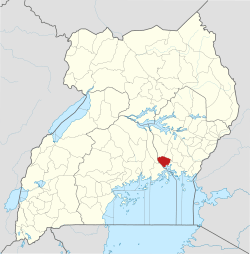Kakira Sugar Works
Kakira Sugar Works Limited, often referred to as Kakira Sugar Works (KSW), is a leading sugar manufacturer in Uganda, the third-largest economy in the East African Community.[1]
| Private | |
| Industry | Manufacture and distribution of sugar |
| Founded | 1 January 1930 |
| Headquarters | Kakira, Uganda |
| Products | Sugar |
Number of employees | 7,500+ (2011) |
| Website | www.kakirasugar.com |
Location
The main factories of the company are located in the town of Kakira, in Jinja District, Eastern Uganda. This location lies approximately 16 kilometres (9.9 mi), by road, northeast of Jinja, the nearest large town.[2] Kakira is located approximately 100 kilometres (62 mi), by road, east of Kampala, the capital of Uganda and the largest city in that country.[3] The coordinates of the main factory are:0°30'36.0"N, 33°17'24.0"E (Latitude:0.5100; Longitude:33.2900).[4] In addition to the factories in Kakira, the company maintains a corporate office along 5th Street, in Bugoloobi, in Kampala Industrial Area, and offices and warehouses, in Kakira, Jinja and Kampala.
Overview
Kakira Sugar Works is the largest manufacturer of sugar in Uganda, producing an estimated 165,000 metric tonnes of sugar annually, accounting for about 47% of the national output in 2011.[5][6]
Kinyara Sugar Works in Masindi District is Uganda's second-largest sugar manufacturer, accounting for about 31% of annual national output. Sugar Corporation of Uganda Limited (SCOUL), in Buikwe District, accounts for about 17% of national production. The remaining 5% (about 15,000 metric tonnes annually), is produced by Sango Bay Estates Limited, in Sango Bay, Rakai District.(See Annual Production & Market Share Among Uganda's Sugar Manufacturers)
The sugar produced by the companies is marketed to the Eastern African countries of South Sudan, Democratic Republic of the Congo, Burundi, Rwanda, Tanzania, Kenya and Uganda. Kakira Sugar Works is the flagship business of the Madhvani Group of Companies, the largest conglomerate in Uganda, accounting for over 10% of the Gross Domestic Product (GDP) of Uganda in 2010.[7] Kakira Sugar Works possesses its own social infrastructure : free schools for employees' children, roads, hospitals, staff housing...[8]
History
In 1920, the Vithaldas Haridas & Company, under the management of Muljibhai Madhvani, a twenty-six-year-old Indian-born Ugandan businessman, entrepreneur, industrialist and philanthropist, purchased 800 acres (3.2 km2) of land, in Kakira, between Jinja and Iganga, for the purpose of starting a sugar factory.[9] Muljibhai later became the managing director of Vithaldas Haridas & Company. That sugar complex, later renamed Kakira Sugar Works, opened in 1930. By adding to the original parcel of land, through purchases, the company land holdings at Kakira, were in excess of 9,500 hectares (37 sq mi), as of April 2009.[10] The sugar manufacturing complex at Kakira employs over 7,500 people, according to the company website.
In 1987, Kakira Sugar Works went through a $59.38 million rehabilitation program funded by the World Bank and the African Development Bank. In 2000, the Madhvani group acquired 100% of Kakira Sugar Works' shares.[9]
Ownership
Kakira Sugar Works is a (100%) subsidiary of the Madhvani Group, based in Kakira, Uganda. The Group's shareholding is private and is not widely, publicly known.
Expansion and upgrade
As of November 2013, Kakira Sugar Works Limited had gone through a US$75 million (about UGX:191 billion) factory expansion and upgrade. US$30 million (about UGX:76.5 billion), was raised through a 10-year corporate bond on the Uganda Securities Exchange, and the remainder was sourced from local banks. This upgrade boosted the factory's sugarcane crushing capacity to 7,500 tonnes per day. The co-generation capacity of Kakira Power Station, was also increased from 22 Megawatts to 52 Megawatts.[11]
Ethanol production
In November 2016, KSW started production of industrial-grade ethanol, distilled from molasses, produced as a by-product of sugar manufacturing. The ethanol distillery, was constructed by Praj Industries of India, at a cost of US$36.6 million (Shs133 billion). The distillery is expected to process the 74,000 metric tonnes of molasses that the sugar mill produces annually, into 20,000,000 litres (4,399,385 imp gal; 5,283,441 US gal) of "fuel grade anhydrous ethanol".[12][13]
See also
- Kakira
- Jinja
- Jinja District
- Madhvani Group
- Muljibhai Madhvani
- Kakira Power Station
- Uganda Sugar Factories
References
- Senelwa, Kennedy (17 January 2015). "Kakira set to produce ethanol in 2016". The EastAfrican. Nairobi. Retrieved 16 November 2018.
- "Road Distance Between Jinja And Kakira With Map". Globefeed.com. Retrieved 13 July 2014.
- "Map Showing Kampala And Kakira With Distance Marker". Globefeed.com. Retrieved 13 July 2014.
- Google, . "Location of Kakira Sugar Works at Google Maps". Google Maps. Retrieved 13 July 2014.CS1 maint: numeric names: authors list (link)
- Among, Barbara (8 December 2008). "Kakira Doubles Sugar Production". New Vision. Archived from the original on 22 October 2014. Retrieved 13 July 2014.
- Ojambo, Fred (5 April 2011). "Ugandan Sugar Producers Plan to Invest $197 Million to Expand, Diversify". Bloomberg News. Retrieved 13 June 2014.
- KSW, . (2011). "Kakira Sugar Works: Our History". Kakira Sugar Works (KSW). Retrieved 13 July 2014.CS1 maint: numeric names: authors list (link)
- Flick, David (2007). Africa: Continent of Economic Opportunity. SE Publisher. p. 349. ISBN 1-919855-44-0. Retrieved 5 April 2015.
- "About us". Kakirasugar.com. Retrieved 5 April 2015.
- Odongo, Jacobs (29 July 2008). "From India, Penniless, Madhvani Made A Fortune in Uganda". New Vision. Archived from the original on 10 July 2015. Retrieved 13 July 2014.
- Kulabako, Faridah (15 November 2013). "Kakira Sugar Issues Shs76 Billion Bond To Raise Capital For Expansion". Daily Monitor. Kampala. Retrieved 16 November 2018.
- Mufumba, Isaac (9 January 2017). "Kakira Sugar opens Shs130b ethanol plant". Daily Monitor. Kampala. Retrieved 16 November 2018.
- Mufumba, Isaac (23 February 2017). "How Kakira factory is turning sugarcane waste into fuel". Daily Monitor Mobile. Kampala. Retrieved 16 November 2018.
